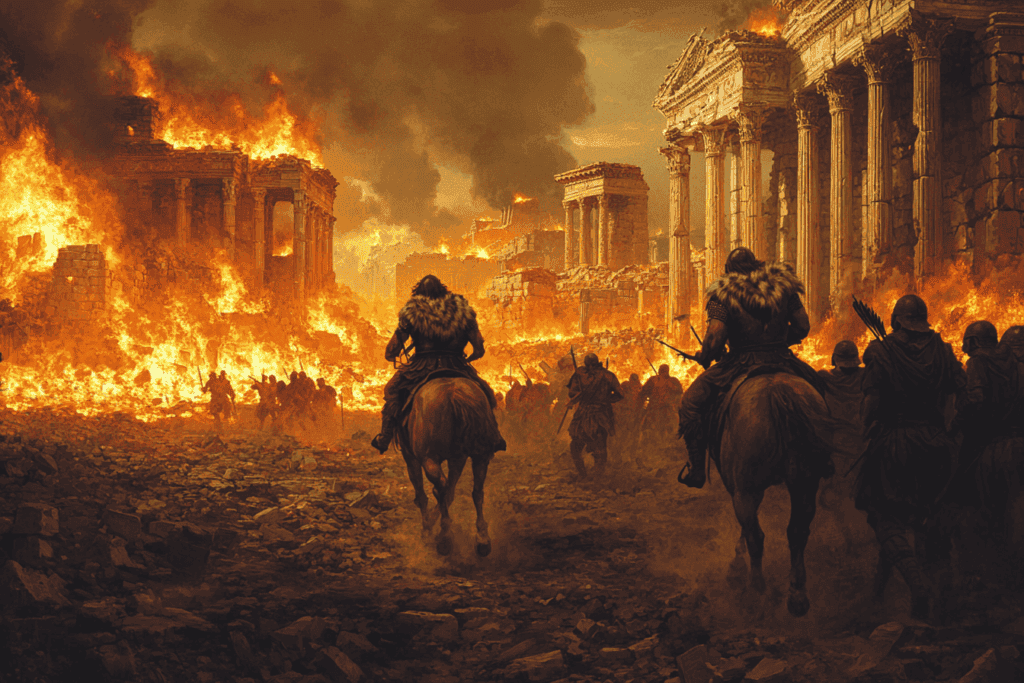
Background and Tensions
The roots of this invasion can be traced back to the early 440s. In 443, the Eastern Roman Empire, under Emperor Theodosius II, had ceased paying the agreed-upon tribute to the Huns. This decision, likely motivated by financial strain and a desire to assert Roman strength, proved to be a critical miscalculation.
By 447, tensions between the Huns and the Eastern Empire had reached a boiling point. Attila, now the sole ruler of the Hunnic Empire after the death of his brother Bleda in 445, sent an embassy to Constantinople to voice his grievances. He complained about the cessation of tribute payments and accused the Romans of harboring Hunnic fugitives. The Hun leader threatened war, noting that his people were growing restless and some had already begun raiding Roman territory.
The Romans, perhaps underestimating the Hunnic threat or overconfident in their defenses, refused to resume tribute payments or hand over the refugees. This refusal would prove to be the spark that ignited Attila’s fury.
The Invasion Begins
In early 447, Attila saw an opportunity too good to pass up. An earthquake had struck Constantinople in January, partially destroying its formidable walls. Seizing this moment of vulnerability, Attila mobilized his forces and prepared for a massive invasion of the Eastern Roman Empire.
The Hunnic army that crossed the Danube was a formidable force. It included not only Huns but also subject peoples such as the Gepids under their king Ardaric and the Goths led by King Valamer. This diverse coalition of warriors, united under Attila’s leadership, would prove to be a nightmare for the Roman defenders.

The Fall of the Danubian Fortresses
Attila’s first target was the line of Roman fortifications along the Danube. These forts, which had long served as the empire’s first line of defense against barbarian incursions, fell quickly to the Hunnic onslaught. The speed and ferocity of the attack caught the Romans off guard, leaving the Balkan provinces exposed.
Among the first cities to fall was Constantia, a key fortress on the Danube. Its sister city, Margus, soon followed in a tale of betrayal that exemplified the terror Attila inspired. The bishop of Margus, fearing for his life, made a secret deal with the Huns. He lured the city’s defenders into an ambush and then opened the gates to Attila’s forces. This act of treachery allowed the Huns to quickly overrun the city, setting a grim precedent for what was to come.
The Battle of the Utus
As news of the Hunnic advance spread, the Eastern Roman military scrambled to mount a defense. Arnegisclus, the magister utriusque militiae (master of both infantry and cavalry) of Thrace, took command of the Roman forces. Marching westward from his base at Marcianopolis, Arnegisclus aimed to intercept the Hunnic army before it could penetrate deeper into Roman territory.
The two armies met at the Utus River (modern-day Vit River) in the province of Dacia Ripensis, south of the Danube. This encounter, known as the Battle of the Utus, would prove to be a pivotal moment in the campaign.

Details of the battle are scarce, but it’s clear that it was a hard-fought and bloody affair. The Romans, despite their discipline and superior equipment, found themselves outmatched by the mobility and ferocity of the Hunnic forces. Arnegisclus himself fought bravely, but was killed in the thick of the battle.
While the Battle of the Utus ended in a victory for Attila, it came at a significant cost. Both sides suffered heavy losses, which would have implications for the rest of the campaign. Among the Byzantine survivors was a middle-aged officer named Marcianus, who would later become Emperor of the Eastern Roman Empire.
The Sack of Marcianopolis and the March to Constantinople
With the main Roman army defeated, Attila pressed his advantage. He turned his attention to Marcianopolis, the capital of the province of Moesia Secunda and a major Roman city. Despite its strong fortifications, Marcianopolis fell to the Huns and was thoroughly sacked. Such was the destruction that it was not inhabited again for almost a century.
The fall of Marcianopolis sent shockwaves through the Eastern Roman Empire. It demonstrated that even well-defended cities were not safe from Attila’s wrath. As panic spread, Attila set his sights on the ultimate prize: Constantinople itself.
The Hunnic army advanced rapidly towards the Eastern Roman capital. By late March or early April, they had reached the outskirts of the city. However, Attila found himself facing an unexpected challenge. Despite the damage caused by the January earthquake, the walls of Constantinople had been rapidly repaired.
The Siege of Constantinople and the Battle of Chersonesus
Realizing that a direct assault on the restored walls would be futile, Attila changed his strategy. He spread his forces out, reaching the sea at both the Black Sea and the Sea of Marmara, effectively cutting Constantinople off from the rest of Thrace.
In a desperate attempt to break the Hunnic encirclement, a Roman army under the command of Aspar engaged the Huns near the Thracian Chersonese (modern-day Gallipoli peninsula). This battle, known as the Battle of Chersonesus, ended in another decisive victory for Attila. The defeat at Chersonesus left Constantinople even more isolated and vulnerable.
The Ravaging of Thrace and Greece
Unable to take Constantinople itself, Attila turned his attention to the surrounding countryside. The Hunnic army fanned out across Thrace, leaving a trail of destruction in its wake. Contemporary accounts speak of “seventy cities” being destroyed during this phase of the campaign.
The Huns didn’t limit themselves to Thrace. They pushed southward into Greece, their raiding parties reaching as far as the famed Pass of Thermopylae. This was a shocking development for the Romans, as it marked the deepest penetration of a “barbarian” force into Greece since the Gothic invasions of the previous century.
Cities and towns across the region were sacked and burned. The Huns showed little mercy, slaughtering or enslaving much of the population they encountered. The once-prosperous provinces of the Eastern Roman Empire were reduced to a wasteland.

The Impact on the Eastern Roman Empire
The psychological impact of Attila’s raid cannot be overstated. The Eastern Roman Empire, long considered the more stable and prosperous half of the Roman world, had been humbled. The sight of Hunnic warriors at the gates of Constantinople and raiding as far south as Thermopylae shattered the illusion of Roman invincibility.
The economic damage was equally severe. The Balkan provinces, which had been a key source of manpower and resources for the empire, lay in ruins. Agricultural production was disrupted, trade routes were severed, and countless people were killed or displaced.
Moreover, the military losses suffered by the Eastern Romans were significant. The defeat at the Battle of the Utus and the subsequent Battle of Chersonesus had decimated their field armies. It would take years for the Eastern Roman military to recover from these losses.
Attila’s Withdrawal and the Aftermath
Despite his overwhelming success, Attila did not attempt to establish permanent control over the territories he had ravaged. Several factors likely contributed to his decision to withdraw back across the Danube.
Firstly, the Hunnic army, despite its victories, had suffered significant casualties. The battles at the Utus and Chersonesus, while successful, had taken their toll. Additionally, the Huns’ mode of warfare, based on rapid movement and plunder, was not well-suited to long-term occupation of settled territories.
There’s also evidence that disease may have begun to affect the Hunnic army. Some historians suggest that an outbreak in the Hunnic camp may have forced Attila to cut his campaign short.
Finally, while Constantinople itself remained untaken, the devastation wrought upon the surrounding regions had achieved many of Attila’s objectives. The Eastern Roman Empire was humbled, its resources plundered, and its ability to resist future Hunnic demands severely weakened.
The Treaty of Anatolius
In the wake of Attila’s withdrawal, the Eastern Roman Emperor Theodosius II was forced to sue for peace. The resulting agreement, known as the Treaty of Anatolius (named after the Roman negotiator), was heavily slanted in favor of the Huns.
Under the terms of the treaty:
- The Romans agreed to resume tribute payments to the Huns, but the yearly tribute was tripled to 2,100 Roman pounds.
- The emperor also agreed to pay over 6,000 Roman pounds of gold.
- Territorial concessions: a vast no-man’s land was established in Roman territory south of the Danube, effectively ceding control of this area to the Huns and leaving their border defenseless against future Hunnic incursions.
This treaty marked a low point for Eastern Roman diplomacy and highlighted the shift in power dynamics between the empire and its “barbarian” neighbors.

Long-term Consequences
The raid of 447 had far-reaching consequences for both the Eastern Roman Empire and the Hunnic confederation.
For the Eastern Romans, the invasion exposed critical weaknesses in their defensive strategy. It prompted a reevaluation of their military and diplomatic approaches to dealing with external threats. The financial strain of the increased tribute payments and the cost of rebuilding the devastated provinces would be felt for years to come.
The success of the raid also emboldened Attila. Having brought the Eastern Roman Empire to its knees, he began to look westward. In 451, just four years after his Balkan campaign, Attila would launch an invasion of Gaul, bringing him into conflict with the Western Roman Empire and its allies.
However, the 447 campaign also marked the apex of Hunnic power. The losses suffered during the invasion, combined with the logistical challenges of maintaining such a vast empire, began to strain the Hunnic confederation. After Attila’s death in 453, the Hunnic Empire would rapidly disintegrate, unable to maintain the unity and momentum that had made it such a formidable force.




